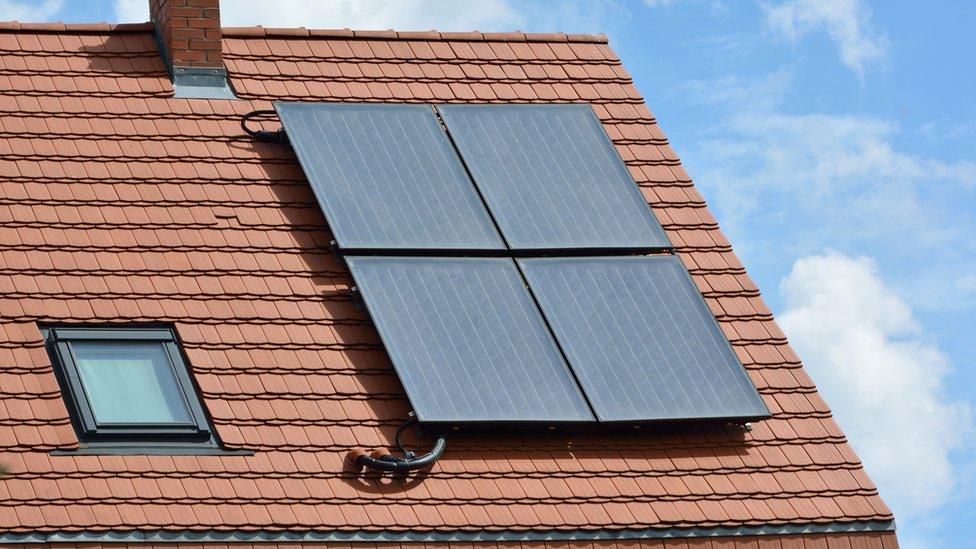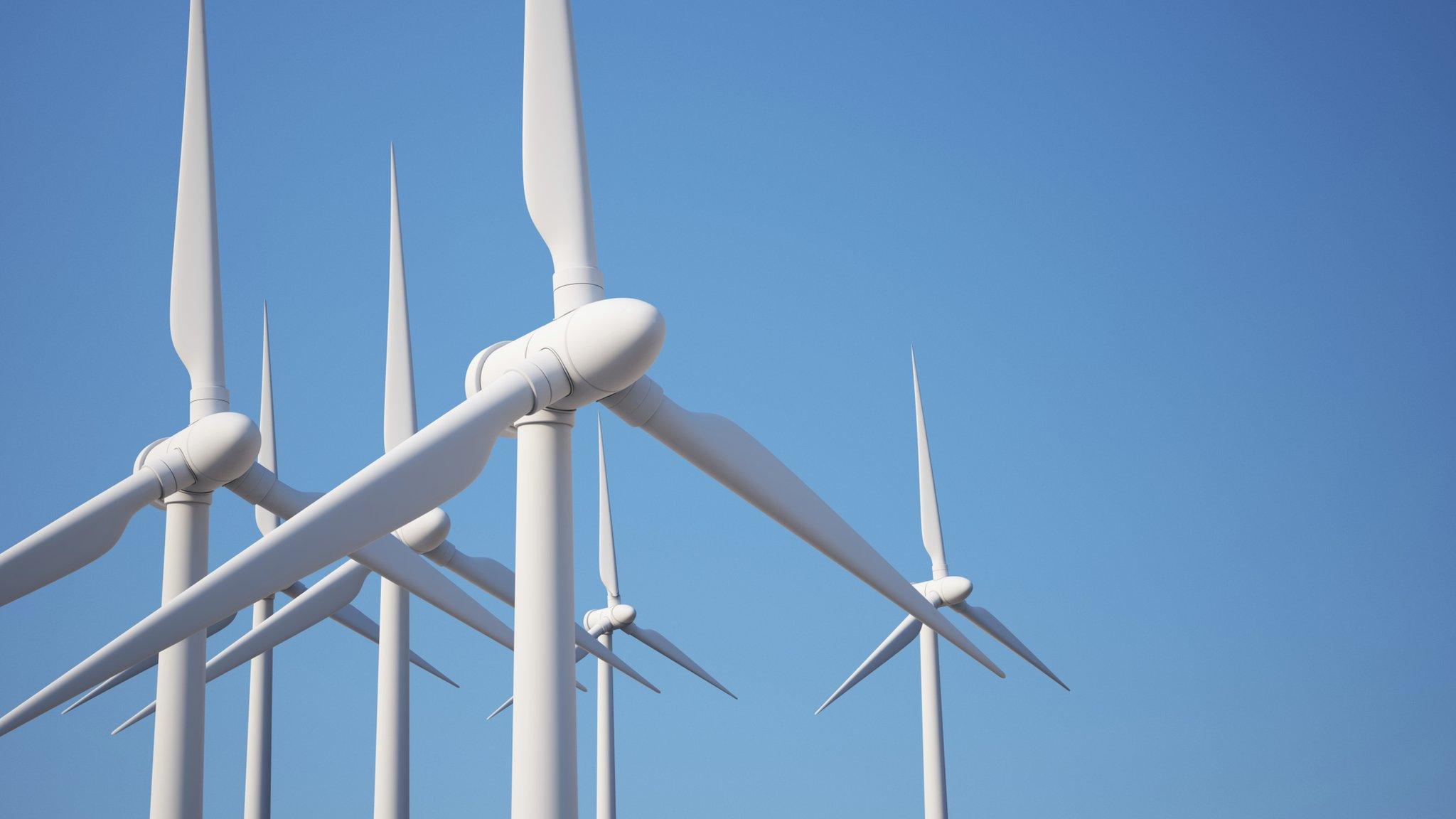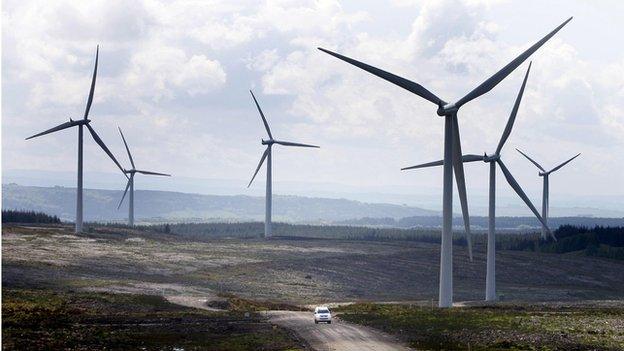High winds boost Scottish turbine output
- Published

Wind power output in Scotland rose by more than a third in September compared with the same time last year, according to renewable energy analysts.
WeatherEnergy also estimated it was the first time all of Scotland's electricity needs had been met by wind on two days in a month.
The company said turbines provided the equivalent of 127% of demand on 24 September and 107% on the 29 September.
There were high winds across Scotland on both days, the Met Office said.
Winds were gusting up to 45mph at low levels in many parts of Scotland on 24 September.
And a yellow be aware warning for wind was issued by forecasters on the 29th, with winds gusting in the "high 60s" on higher ground and at about 50mph at lower levels.
WeatherEnergy said its analysis indicated wind turbines in Scotland provided 766,116 MWh of electricity to the National Grid - a 36% increase compared with September 2015 and enough to meet the electrical needs of 87% of Scotland's 2.1 million homes.
Anti-turbine group Scotland Against Spin labelled the figures "pure propaganda for the energy illiterate", saying it was no news Scotland was producing more wind energy every month as more turbines became operational.
They also said there were other days in September when wind output was low and demand was high.

Analysis
Kevin Keane, Environment Correspondent, BBC Scotland
More wind turbines are being built in Scotland and so the capacity to generate energy from wind is increasing. But that's far from the full story. There's still a big gap between the ambitions of the environmental groups and the practicalities highlighted by people who object to wind farms.
In headline terms, this looks like a big shift towards wind. But there are a lot of caveats. Two dates are highlighted where energy from wind was, according to the research, greater than energy consumption. But what do we know about those days?
For a start, they are both in the early part of the autumn where temperatures are still relatively high. That means most people are resisting the urge to put on their heating and so demand for domestic energy is restricted to lights, cooking and appliances.
And according to the Met Office, both dates were quite windy with gusts from 40mph on both days. So all the turbines were turning but demand was low.
That said, it is significant that this year, for the first time, Scotland has had the capacity to generate all its energy needs from wind on several occasions. But when there's no wind - on those warm summer days - there's no wind power. And in the depths of a cold winter, when wind is aplenty, energy consumption shoots through the room as the central heating goes on.
This is why we hear politicians talking about the energy mix. Clean, renewable energy is good for climate change. But we still need something to keep the lights on in between and, for now at least, that means fossil fuels and nuclear.

'Energy illiterate'
Prof Stuart Haszeldine of Edinburgh University, who researches renewable energy and carbon capture and storage, told the Good Morning Scotland programme it was a "terrific achievement".
He said: " When I think about where we started about 10 or 15 years ago, we only had maybe a few percentages - ten or 15% of our energy from very low carbon sources.
"Scotland in particular has managed to move ahead and very successfully managing to generate a large part of its own electricity from carbon free sources."
However, Prof Haszeldine said the unpredictability of wind and other renewables as an energy source meant a lot more work was needed to harness their potential.
He said: "Although we applaud this great success in generating lots of renewable power, we have to be aware that this isn't constant and we need to look at how to use the excess energy and also how to store electricity and energy for when there's not enough renewables being generated."
Scotland Against Spin spokeswoman Linda Holt said there were days when wind output was very low.
She said: "On 15 September the UK's 12 GW of wind turbines were producing less than 0.3 GW while coal and gas generation had to be ramped up to winter levels.
"Wind output was almost as low on 20 September at 18:00, the time of peak demand. These were some of the lowest minimum figures for wind for 2016.
"The point is wind energy is wildly variable and it cannot be ramped up according to demand. This means the more wind energy we have in our electricity system, the more conventional generation we need for when the wind isn't blowing."

WWF Scotland called the wind output figures for September "astonishing".
The conservation charity's director for Scotland, Lang Banks, said: "That Scotland has made such great strides in generating renewable power and addressing climate change is the result of many years of political and public support.
"However, if we are to continue to play a leading role globally in cutting carbon emissions, we need politicians to build on our renewable electricity revolution and expand it to other sectors such as heat and transport."
Weather Energy also said its latest figures showed that, for homes fitted with solar panels, there was enough sunshine in September to generate an estimated 70% of the electricity needs of an average household in Aberdeen.
Dundee households with solar panels could have expected 69% of their electricity needs to be met, dropping to 50% in Glasgow, the company said.
- Published20 July 2016

- Published3 May 2016

- Published25 April 2016
